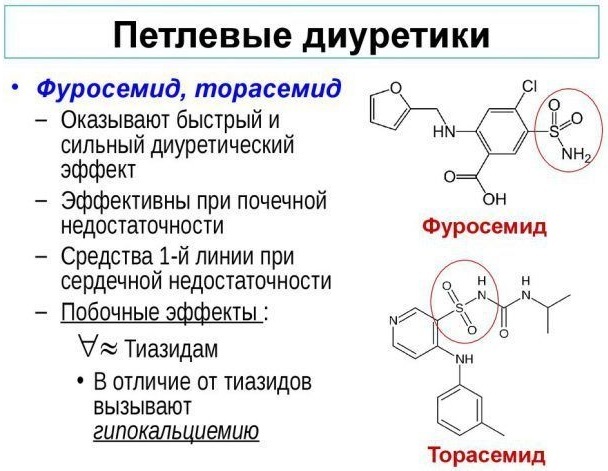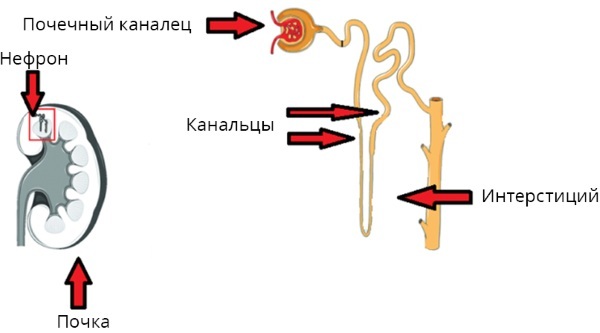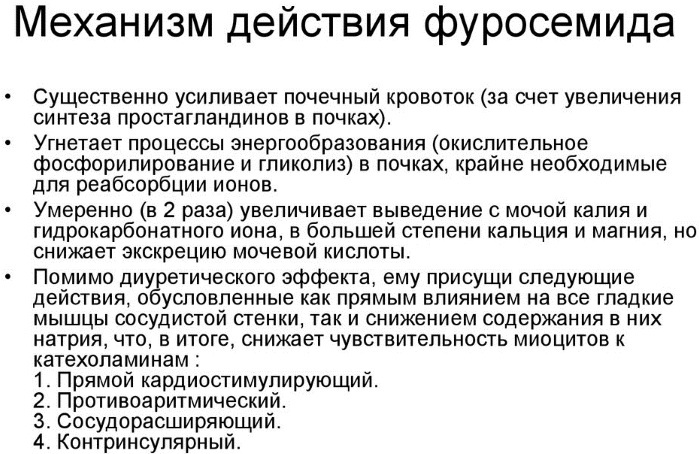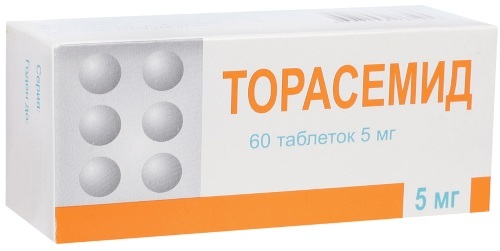Diuretics are drugs that increase the excretion of urine, reduce the water content in the tissues and serous cavities of the body. Their list is presented by several groups. One of these is loop diuretics.
Record content:
-
1 Properties of drugs
- 1.1 Flaws
- 2 Mechanism of action
- 3 Basic indications
- 4 Negative action and contraindications
-
5 Frequently prescribed loop diuretics
- 5.1 Furosemide
- 5.2 Torasemid
- 6 Injections
- 7 Features of use during pregnancy
- 8 Compatibility with other medicines
- 9 Prices in Moscow, St. Petersburg and regions
- 10 Diuretic Videos
Properties of drugs
Loop diuretics (the list of drugs with diuretic properties is headed by this group) are considered the most powerful diuretics.
Their other name is ceiling and highly active diuretics. By their chemical structure, they are derivatives of sulfamoylanthranilic acid. Loop diuretics induce intense dose-dependent diuresis in a short time.
Advantages
The benefits of loop diuretics include:
- diuretics are available both in tablets and in injection solutions, which allows them to be used to treat patients who cannot take medications by mouth;
- injectable forms make them convenient for use in hospital and intensive care units;

- the effect of medications develops quickly, after getting inside, the effect of them begins after 0.5-1.5 hours and lasts up to 2-6 hours;
- loop diuretics eliminate edema, reduce intracellular fluid and shortness of breath, improve respiratory function, and lower blood pressure.
Flaws
The disadvantages of diuretics include the following:
- Strong loop diuretics are used once or in short courses, intermittently. Their treatment should not be long.
- If you use them every day, then there is an addiction to them and the effectiveness of diuretics is weakened.
- The action of diuretics is strong but short. This allows them to be used to relieve hypertensive crisis. But for the treatment of hypertension, only if it is not associated with heart failure, it is better to use thiazide diuretics. They are considered to be more secure.
- They remove Na and K ions from the body, which causes a shift in the water-salt balance and development dangerous undesirable effects, such as severe hypotension, convulsions, encephalopathy, heart failure rhythm. When injected into a vein, they can provoke partial or complete deafness.
Mechanism of action
Loop diuretics have the following effects on the human body:
- suppress the system of transport of ions Na, K, Cl;
- show a saluretic effect, that is, they remove Na and Cl ions;
- inhibit the re-assimilation of Na and water in the kidneys;

- reduce osmotic pressure inside cells;
- bind fluid and increase the amount of urine excreted;
- increase the excretion of potassium in the distal renal tubules;
- accelerate the release of Ca2+ and Mg2+;
- stimulate the renin-angiotensin-aldosterone system;
- lower blood pressure.
Basic indications
Loop diuretics are recommended for the following pathologies:
- edema associated with chronic insufficiency (cardiac and renal), nephrotic syndrome, liver pathologies;
- acute renal failure, including in women carrying a child, with burn disease;
- hypertension.
In injections, loop diuretics are recommended for pasty due to acute heart failure. They are also used for treatment by forced diuresis in case of chemical intoxication.
Negative action and contraindications
Loop diuretics (the list of drugs is small, so it's easy to remember a number of restrictions on their use) are prohibited, if the patient has the following health problems:
- intolerance to the composition of the diuretic;
- hypersensitivity to sulfonamides;
- severe kidney disease;

- violations of the discharge of urine of various nature;
- severe liver dysfunction;
- alkalosis;
- dehydration;
- an increase in the content of uric acid in the blood;
- high pressure in the central veins.
Diuretics should not be prescribed in case of an overdose of glycosidic cardiotonics. They are also contraindicated if the patient is undergoing a course of cephalosporins and aminoglycosides. Furosemide is contraindicated in gout. Medicines based on torasemide are not used in pediatric practice.
Diuretics should be prescribed with caution in patients with health problems such as:
- hypotension associated with stenosis of the coronary and cerebral arteries;
- acute myocardial infarction;
- diabetes;
- hepatorenal syndrome;
- low protein content in the blood;
- violation of urination, which is associated with prostate adenoma, urethral stricture, dropsy of the kidney;
- hearing loss;
- inflammation of the pancreas;
- stomach upset;
- violation of the heartbeat;
- Liebman-Sachs disease.
Pill diuretics may contain milk sugar, which is why they are prohibited if you are lactose intolerant.
Diuretic therapy can cause secondary effects:
- hypotension, collapse, increased heart rate, heart rhythm disturbances, hypovolemia, thrombophlebitis;
- intense headaches, drowsiness, muscle weakness, sensory disturbances, cramps in the lower extremities, dizziness;
- indifference to what is happening, impaired consciousness, powerlessness, decrease or complete cessation of motor activity;
- blurred vision, hearing loss, ringing in the ears;
- refusal to eat, thirst, dry mouth, nausea, vomiting, indigestion, stool retention, inflammation of the pancreas, intrahepatic cholestasis;
- erectile dysfunction;
- urinary retention, the appearance of blood in the urine, interstitial nephritis;

- allergy;
- a decrease in the level of hemoglobin, the number of leukocytes and platelets, an increase in the content of eosinophils;
- dehydration;
- lowering the level of K, Na, Ca, Mg and Cl in the body;
- metabolic alkalosis;
- increased sugar, cholesterol, creatine, blood urea levels;
- the appearance of glucose and calcium in the urine;
- increased activity of liver enzymes.
When a diuretic is prescribed in injections, it can cause pain at the injection site. In infants born prematurely, stones may be deposited in the urinary system, and the Botall's duct may not close.
If the therapeutic dosage is exceeded, loop diuretics can provoke an overdose, which is manifested by the following signs:
- drop in blood pressure;
- collapse;
- shock;
- dehydration;
- decrease in the amount of circulating blood;
- drowsiness;
- confusion of consciousness.
In addition, after exceeding the dose of Furosemide, a clinical picture of poisoning with it may appear:
- thickening of the blood;
- arrhythmia;
- indifference to what is happening;
- flaccid paralysis;
- thrombosis;
- acute renal failure, which is accompanied by urinary retention;
- thromboembolism.
In case of an overdose of Torasemide, gastrointestinal upset may occur.
In any case, no antidote is known for any signs of loop diuretic poisoning. Therefore, symptomatic therapy is indicated, the normalization of acid-salt balance and the amount of circulating blood. If the diuretic is taken orally, then the victim is recommended to induce vomiting and take an adsorbent, for example, Smecta.
During the period of therapy with diuretics, one should refrain from driving a car and activities related to potentially hazardous production, because they can cause dizziness, impotence, muscle weakness and sleepiness.
With a sufficiently long course of treatment with diuretics, drugs (or diets) are prescribed to compensate for the loss of potassium.
Frequently prescribed loop diuretics
Loop diuretics include the following medications:
- Furosemide;

Furosemide is the most popular loop diuretic - Torasemide.
The list of drugs from the loop diuretic group used to be wider, as it included drugs based on ethacrynic acid, but they are now discontinued. On sale one could find Uregit, which was produced in tablets. It was prescribed for edema of various origins and hypertension, when other diuretic drugs were ineffective.
From foreign diuretics of this group, drugs containing bumetamide (Bumex, Bufenox) are known. They are used for renal failure and hypertension. Currently, these drugs are being tested as drugs for the treatment of epilepsy and autism.
Furosemide
The main and well-proven representative of the group is Furosemide. It is taken orally on an empty stomach, the effect of it develops within half an hour and reaches its maximum after 1-2 hours after oral administration. The effect of the medication lasts up to 4-6 hours.
The tablets must be swallowed whole with plenty of water.
Adults should not take more than 1.5 g of Furosemide per day, children over 40 mg.
The duration of therapy is selected by the doctor for each person individually. The drug effectively removes water from the body, as a result of which edema subsides, including those caused by kidney problems. The drug quickly normalizes high blood pressure, reduces the load on the myocardium, the amount of circulating blood.
The medication has the following disadvantages:
- Furosemide does not eliminate the root cause of pastiness and is prescribed only as symptomatic therapy, as a means of "emergency aid".
- If the course of therapy with them lasts longer than 14 days, then the likelihood of adverse events from a diuretic increases.
- The drug flushes magnesium and potassium from the body, which causes seizures.
- Diuretic treatment often leads to intense thirst as the body tries to replenish lost fluid.
- Furosemide has many contraindications.
- During treatment with a diuretic, the excretion of sodium ions increases significantly, and after its completion, the rate elimination is significantly reduced and the "rebound" syndrome is observed, which is characterized by the appearance edema.
The complete analogue of Furosemide is Lasix.
Torasemid
Torasemide is produced by several Russian and foreign companies, so they may differ in the composition of inactive components, which should be taken into account by patients prone to allergies.
Complete analogues of Torasemide are the following medicines:
- Britomar;
- Lawtonel;
- Diuver;
- Trigrim.
They are used for hypertension, edema of a different nature, for example, arising from dysfunction of the kidneys and heart.
They need to be taken once a day at any convenient time. The tablets must be swallowed whole with plenty of water. They should be drunk with or without food. The daily dosage can range from 2.5 mg to 20 mg. Torasemide reduces the severity of fibrosis and diastolic ventricular dysfunction. In addition, it lowers blood pressure regardless of body position.
Compared with Furosemide, it has the following advantages:
- It is more effective for chronic kidney dysfunction.
- It removes less potassium from the body.
- Longer duration of action.
- Side effects are less common.
- It can be drunk with edema that appears at the end of the Furosemide course.
Injections
Loop diuretics, listed above, are not available in injectable form. An exception is Furosemide or Lasix, which is available both in tablets and in ampoules.
After the injection, the effect of the drug appears within 5 minutes. That is why it can be used to relieve a hypertensive crisis, with intoxication with chemicals that are excreted in the urine unchanged. It is recommended for severe hypertension.
The diuretic should be administered intravenously slowly. Intramuscular injections are allowed, but only if it is not possible to inject the medication into a vein. Injectable forms of a diuretic are convenient when the patient, for some reason, cannot take the medicine by mouth. For example, when the drug is not absorbed due to intestinal problems.
In injections, the medication should be prescribed in the lowest dosages that allow a therapeutic effect to be achieved.
An intramuscular diuretic should not be administered in acute conditions such as pulmonary edema. If the medication is prescribed intravenously, as soon as it is possible to take a diuretic inside, you need to start taking the medication in tablets.
Saline can be used to dilute furosemide for parenteral administration; it should be administered as soon as possible after dilution.
Features of use during pregnancy
Loop diuretics, the list of drugs of which is presented above (with the exception of Trigrim tablets), can be used for patients in a position when the benefit to the mother outweighs the harm to the baby.
Furosemide (Lasix) migrates across the placental barrier, therefore, during the period of therapy, the child's condition should be monitored.
Torasemide has no teratogenic and fetotoxic effects. But it migrates across the placenta, provokes a violation of the water-salt balance and reduces the number of platelets in the fetus. Their treatment should be under the supervision of a physician. Torasemide should be taken by women in the position in the lowest effective dosages.
Compatibility with other medicines
Before starting treatment with loop diuretics, you need to find out if they are compatible with other medicines.
All of them have the following effect on medicines of other groups:
- weaken the effect of hypoglycemic agents and allopurinol;
- increase the effect of theophylline and diazoxide;
- weaken the effect of non-depolarizing muscle relaxants;
- increase the content of salicylates, antibacterial agents, medicines based on platinum, as well as the likelihood of a toxic effect from them on the kidneys and ears;
- reduce the excretion of drugs with lithium and increase the risk of intoxication with them;
- enhance the effect of antihypertensive drugs;
- reduce the renal elimination of methotrexate or probenecid, and they can reduce the effectiveness of diuretics.
Sympathomimetic amines and overhead diuretics weaken each other. Cholestyramine reduces bioavailability and weakens the effectiveness of diuretics. Medicines that inhibit the transport of substances into the lumen of the tubules increase the content of diuretics in the blood serum.
When administered together with diuretics glucocorticoids, amphotericin B, the likelihood of hypokalemia increases.
When diuretics are prescribed concurrently with ACE inhibitors or angiotensin 2 receptor blockers, severe hypotension may occur. To prevent this from happening, you can either reduce the dosage of the diuretic or cancel it for a while.
When taking torasemide in combination with cyclosporine, the likelihood of gouty arthritis increases.
When torasemide and X-ray contrast agents are prescribed to people at risk of nephropathy, the likelihood of dysfunction of the kidneys, so that it occurs less often before the introduction of a radiopaque substance, an intravenous hydration.
Furosemide solution for injection has an alkaline medium, so it cannot be combined with medications with a pH less than 5.5.
Prices in Moscow, St. Petersburg and regions
Loop diuretics, the list of drugs for which is presented above, have different costs.
Their approximate price in rubles. next:
| City | Furosemide in tablets of 0.04 g No. 50 produced by Ozone LLC | Furosemide in injections produced by JSC "Borisov Plant of Medical Preparations" | Torasemide, which is manufactured by Ozone LLC at 5 mg No. 20 | Diuver 5 mg, 20 tablets per pack | Diuver 10 mg No. 20 |
| Moscow | 33 | 28 | 134 | 313 | 406 |
| St. Petersburg | 30 | 29 | 141 | 315 | 418 |
| Kazan | 31 | 27 | 132 | 325 | 419 |
| Novosibirsk | 35 | 26 | 136 | 335 | 430 |
All loop diuretics are prescription drugs and should not be self-medicated. Self-administration of powerful diuretics can lead to serious consequences.
Article design: Vladimir the Great
Diuretic Videos
Action of diuretics in the kidneys:



